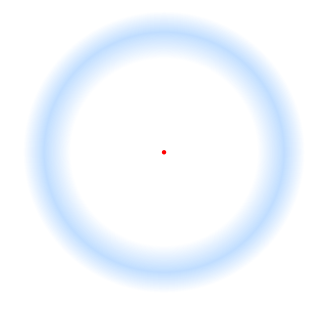
In visual perception, an optical illusion is an illusion caused by the visual system and characterized by a visual percept that arguably appears to differ from reality. Illusions come in a wide variety; their categorization is difficult because the underlying cause is often not clear but a classification proposed by Richard Gregory is useful as an orientation. According to that, there are three main classes: physical, physiological, and cognitive illusions, and in each class there are four kinds: Ambiguities, distortions, paradoxes, and fictions. A classical example for a physical distortion would be the apparent bending of a stick half immerged in water; an example for a physiological paradox is the motion aftereffect. An example for a physiological fiction is an afterimage. Three typical cognitive distortions are the Ponzo, Poggendorff, and Müller-Lyer illusion. Physical illusions are caused by the physical environment, e.g. by the optical properties of water. Physiological illusions arise in the eye or the visual pathway, e.g. from the effects of excessive stimulation of a specific receptor type. Cognitive visual illusions are the result of unconscious inferences and are perhaps those most widely known.

The Necker cube is an optical illusion that was first published as a Rhomboid in 1832 by Swiss crystallographer Louis Albert Necker. It is a simple wire-frame, two dimensional drawing of a cube with no visual cues as to its orientation, so it can be interpreted to have either the lower-left or the upper-right square as its front side.

An afterimage is an image that continues to appear in the eyes after a period of exposure to the original image. An afterimage may be a normal phenomenon or may be pathological (palinopsia). Illusory palinopsia may be a pathological exaggeration of physiological afterimages. Afterimages occur because photochemical activity in the retina continues even when the eyes are no longer experiencing the original stimulus.

Amblyopia, also called lazy eye, is a disorder of sight in which the brain fails to fully process input from one eye and over time favors the other eye. It results in decreased vision in an eye that typically appears normal in other aspects. Amblyopia is the most common cause of decreased vision in a single eye among children and younger adults.
The visual field is "that portion of space in which objects are visible at the same moment during steady fixation of the gaze in one direction"; in modern ophthalmology and neurology it is considered “the field of functional capacity obtained and recorded by means of perimetry”.

Binocular rivalry is a phenomenon of visual perception in which perception alternates between different images presented to each eye.
Multistable perception is a perceptual phenomenon in which an observer experiences an unpredictable sequence of spontaneous subjective changes. While usually associated with visual perception, multistable perception can also be experienced with auditory and olfactory percepts.

Monocular rivalry is a phenomenon of human visual perception that occurs when two different images are optically superimposed. During prolonged viewing, one image becomes clearer than the other for a few moments, then the other image becomes clearer than the first for a few moments. These alternations in clarity continue at random for as long as one looks. Occasionally one image will become exclusively visible and the other image invisible.

Ambiguous images or reversible figures are visual forms that create ambiguity by exploiting graphical similarities and other properties of visual system interpretation between two or more distinct image forms. These are famous for inducing the phenomenon of multistable perception. Multistable perception is the occurrence of an image being able to provide multiple, although stable, perceptions.
Stereopsis is the component of depth perception retrieved through binocular vision. Stereopsis is not the only contributor to depth perception, but it is a major one. Binocular vision happens because each eye receives a different image because they are in slightly different positions on one's head. These positional differences are referred to as "horizontal disparities" or, more generally, "binocular disparities". Disparities are processed in the visual cortex of the brain to yield depth perception. While binocular disparities are naturally present when viewing a real three-dimensional scene with two eyes, they can also be simulated by artificially presenting two different images separately to each eye using a method called stereoscopy. The perception of depth in such cases is also referred to as "stereoscopic depth".
Akinetopsia, also known as cerebral akinetopsia or motion blindness, is a term introduced by Semir Zeki to describe an extremely rare neuropsychological disorder, having only been documented in a handful of medical cases, in which a patient cannot perceive motion in their visual field, despite being able to see stationary objects without issue. The syndrome is the result of damage to area V5, whose cells are specialized to detect directional visual motion. There are varying degrees of akinetopsia: from seeing motion as frames of a cinema reel to an inability to discriminate any motion. There is currently no effective treatment or cure for akinetopsia.

The flash lag illusion or flash-lag effect is a visual illusion wherein a flash and a moving object that appear in the same location are perceived to be displaced from one another. Several explanations for this simple illusion have been explored in the neuroscience literature.

In vision, filling-in phenomena are those responsible for the completion of missing information across the physiological blind spot, and across natural and artificial scotomata. There is also evidence for similar mechanisms of completion in normal visual analysis. Classical demonstrations of perceptual filling-in involve filling in at the blind spot in monocular vision, and images stabilized on the retina either by means of special lenses, or under certain conditions of steady fixation. For example, naturally in monocular vision at the physiological blind spot, the percept is not a hole in the visual field, but the content is “filled-in” based on information from the surrounding visual field. When a textured stimulus is presented centered on but extending beyond the region of the blind spot, a continuous texture is perceived. This partially inferred percept is paradoxically considered more reliable than a percept based on external input..
Flash suppression is a phenomenon of visual perception in which an image presented to one eye is suppressed by a flash of another image presented to the other eye.

The neural correlates of consciousness (NCC) refer to the relationships between mental states and neural states and constitute the minimal set of neuronal events and mechanisms sufficient for a specific conscious percept. Neuroscientists use empirical approaches to discover neural correlates of subjective phenomena; that is, neural changes which necessarily and regularly correlate with a specific experience. The set should be minimal because, under the materialist assumption that the brain is sufficient to give rise to any given conscious experience, the question is which of its components are necessary to produce it.
Continuous flash suppression (CFS) is an adapted version of the original flash suppression method, first reported in 2004. In CFS, the first eye is presented with a static stimulus, such as a schematic face, while the second eye is presented with a series of rapidly changing stimuli. The result is the static stimulus becomes consciously repressed by the stimuli presented in the second eye. A variant of CFS to suppress a dynamic stimulus is also reported
Multistable auditory perception is a cognitive phenomenon in which certain auditory stimuli can be perceived in multiple ways. While multistable perception has been most commonly studied in the visual domain, it also has been observed in the auditory and olfactory modalities. In the olfactory domain, different scents are piped to the two nostrils, while in the auditory domain, researchers often examine the effects of binaural sequences of pure tones. Generally speaking, multistable perception has three main characteristics: exclusivity, implying that the multiple perceptions cannot simultaneously occur; randomness, indicating that the duration of perceptual phases follows a random law, and inevitability, meaning that subjects are unable to completely block out one percept indefinitely.
Binocular rivalry is a visual phenomenon wherein one experiences alternating perceptions due to the occurrence of different stimuli presented to the corresponding retinal regions of the two eyes and their competition for perceptual dominance.
Binocular switch suppression (BSS) is a technique to suppress usually salient images from an individual's awareness, a type of experimental manipulation used in visual perception and cognitive neuroscience. In BSS, two images of differing signal strengths are repetitively switched between the left and right eye at a constant rate of 1 Hertz. During this process of switching, the image of lower contrast and signal strength is perceptually suppressed for a period of time.

Motion silencing is an illusion or perceptual phenomenon in which objects that are rapidly changing in a particular salient property seem to cease changing with motion. The illusion was first identified by Jordan Suchow and George Alvarez in the publication of their research on the topic.











